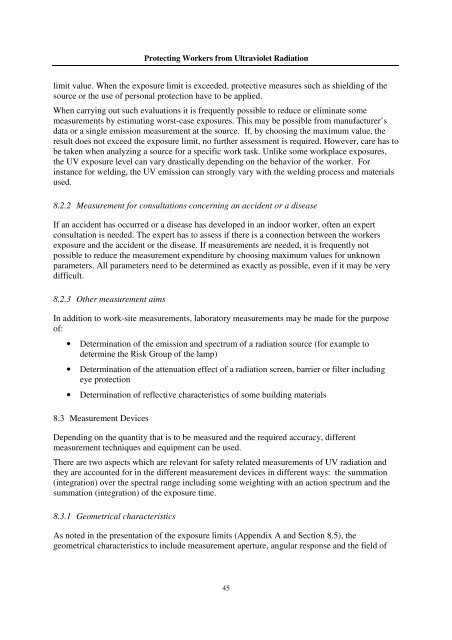Protecting Workers from Ultraviolet Radiation - icnirp
Protecting Workers from Ultraviolet Radiation - icnirp
Protecting Workers from Ultraviolet Radiation - icnirp
Create successful ePaper yourself
Turn your PDF publications into a flip-book with our unique Google optimized e-Paper software.
<strong>Protecting</strong> <strong>Workers</strong> <strong>from</strong> <strong>Ultraviolet</strong> <strong>Radiation</strong><br />
limit value. When the exposure limit is exceeded, protective measures such as shielding of the<br />
source or the use of personal protection have to be applied.<br />
When carrying out such evaluations it is frequently possible to reduce or eliminate some<br />
measurements by estimating worst-case exposures. This may be possible <strong>from</strong> manufacturer’s<br />
data or a single emission measurement at the source. If, by choosing the maximum value, the<br />
result does not exceed the exposure limit, no further assessment is required. However, care has to<br />
be taken when analyzing a source for a specific work task. Unlike some workplace exposures,<br />
the UV exposure level can vary drastically depending on the behavior of the worker. For<br />
instance for welding, the UV emission can strongly vary with the welding process and materials<br />
used.<br />
8.2.2 Measurement for consultations concerning an accident or a disease<br />
If an accident has occurred or a disease has developed in an indoor worker, often an expert<br />
consultation is needed. The expert has to assess if there is a connection between the workers<br />
exposure and the accident or the disease. If measurements are needed, it is frequently not<br />
possible to reduce the measurement expenditure by choosing maximum values for unknown<br />
parameters. All parameters need to be determined as exactly as possible, even if it may be very<br />
difficult.<br />
8.2.3 Other measurement aims<br />
In addition to work-site measurements, laboratory measurements may be made for the purpose<br />
of:<br />
• Determination of the emission and spectrum of a radiation source (for example to<br />
determine the Risk Group of the lamp)<br />
• Determination of the attenuation effect of a radiation screen, barrier or filter including<br />
eye protection<br />
• Determination of reflective characteristics of some building materials<br />
8.3 Measurement Devices<br />
Depending on the quantity that is to be measured and the required accuracy, different<br />
measurement techniques and equipment can be used.<br />
There are two aspects which are relevant for safety related measurements of UV radiation and<br />
they are accounted for in the different measurement devices in different ways: the summation<br />
(integration) over the spectral range including some weighting with an action spectrum and the<br />
summation (integration) of the exposure time.<br />
8.3.1 Geometrical characteristics<br />
As noted in the presentation of the exposure limits (Appendix A and Section 8.5), the<br />
geometrical characteristics to include measurement aperture, angular response and the field of<br />
45



